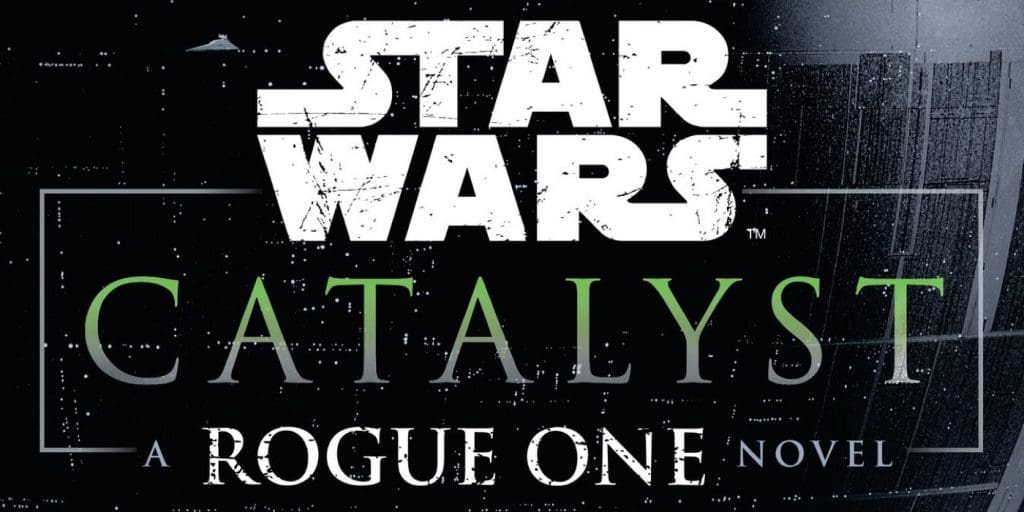Summary
Catalyst: A Rogue One Novel, written by James Luceno, is a tie-in novel released as a direct lead-in to Rogue One: A Star Wars story. I worry about who’s coming up with these titles. Nonetheless, Catalyst introduces characters such as Orson Krennic and the Erso family, while fleshing out details on the creation of the Empire’s Death Star.
Catalyst: A Rogue One Novel is part of the current Star Wars canon. Check out the timeline.
Catalyst: A Rogue One Novel has, I suspect, a target demographic narrower than the Death Star’s trenches. James Luceno, a long-time contributor to the Star Wars Expanded Universe, writes thorough, dry, and impersonal novels. Often encyclopaedic, his work is a treasure trove of titbits that are, essentially, the prose version of How Stuff Works. Here, the topic is the Death Star: How the Empire kept it a secret, how they obtained staff and supplies, and how they made the planet-destroying super-laser.
Catalyst: A Rogue One Novel is, essentially, for the people who have a burning desire to learn who applied the cladding to the Death Star.
There’s more to it than that, but only barely. This is details-over-drama science-fiction that delves into psychology more than emotion. (Luceno is particularly interested in the psychology of great men in positions of political power.) It’s a cold and meticulous novel so stuffed with Star Wars-specific details that it’ll likely alienate anyone who isn’t relatively well-versed in the lore – but, then again, anyone who isn’t well-versed in the lore probably won’t be aware that this book even exists.
About half of Catalyst is set before the fall of the Republic; the other half takes place in the early, uncertain days of the Empire. And while the lead characters are ostensibly Galen and Lyra Erso (the parents of Jyn, Felicity Jones’s character in Rogue One), the person who really drives the plot is Orson Krennic. As the novel opens, he’s a member of the Republic’s Special Weapons Group, driven to rise through the ranks of Imperial bureaucracy by beguiling his old and brilliant friend, Galen Erso, into developing weapons.
This, needless to say, is against the moral principles of Galen, a genius but standoffish expert in kyber crystals. (Those make lightsabers – see what I was saying about the details?). He’s hoping to remain out of the war and use his mind to develop renewable, cheap energy on a galactic scale. Krennic’s ambition results in years of pushing and pulling, which comprises most of the plot.
This wouldn’t be able to sustain a novel of such length were it not for Luceno’s characterisation of the Ersos. Both frequently discuss the nature of compromise and complicity with a wartime regime, but that’s vague, idealistic stuff; what works best are the finer details of their relationship, and how their differences – Galen’s technological yin to Lyra’s spiritual yang – keep them unified even in the most trying of circumstances.
There are disagreements, of course, which is just as well, or there wouldn’t be a story here. Krennic’s attempts to manipulate Galen are focused primarily on his altruism, and their years-long friendship. Galen loves his family deeply and is protective of them, but he doesn’t understand human beings in quite the same way he does formations of ancient, powerful crystals. He’s susceptible to Krennic because unless evidence of something is presented to him explicitly – including betrayal – he won’t accept it. Lyra, on the other hand, is more free-spirited, adherent to the philosophy of the Force and the Jedi, but trusting enough of Galen’s essential nature that she’s willing to trust that he’ll eventually reach the logical conclusion on his own.
The Ersos’ relationship is sweet because it’s meaningful, especially in how mundane it can be. Galen can be arrogant, but purposely downplays his intellect in moments of kindness. His naivety leads to sweet displays of affection, like when he fills a letter to Lyra with scientific notes and diagrams, but Luceno takes the time to display how much he struggles to balance his work with his responsibilities as a husband and father.
If there’s anyone who is underserved here, it’s Krennic, which is odd considering it’s his desire to find Chancellor Palpatine’s ear that drives the entire plot. Unlike how capably Luceno served the backstory of Grand Moff Tarkin in his previous canon novel, Tarkin, here Krennic’s upward climb feels impersonal and, frankly, a bit nebulous. You never get a real sense of what motivates him to betray and manipulate one of his oldest and closest friends, besides simple ambition. But where that ambition comes from is never really addressed – at least not satisfactorily, in my estimation.
How else, though, would Luceno make room for his trademark info-dumps? Here they’re especially dense, chronicling the minutia of the Death Star’s construction from the waning days of the Republic to the early period of the Empire. I’m one of the hopeless dorks who actually cares about this kind of thing, but Luceno still has an issue with bogging down his prose with far too much detail. The best of it is snuck into character-driven stretches of story that serve up interesting details about not just the core cast, but peripheral characters like Palpatine, who’s able to manipulate the Republic into building a superweapon by stoking fear of the Separatists building their own, and even Poggle the Lesser, the public leader of the Geonosians who commits his drones to the station’s construction. A funny administrative detail that Krennic has to deal with is that the drones occasionally freak out and start killing each other for no reason.
Beyond Krennic and the Ersos, Luceno makes a little room for other characters that are important to the canon but not necessarily to this particular story. Has Obitt, an alien smuggler with a developing conscience, is an admirable attempt at an everyman, but he brings humour more than real personality. The rebel leader Saw Gerrera finds himself tied up with the Ersos, but the real payoff for that plot thread is to be found elsewhere, and Tarkin’s brief role is largely in service of jockeying pieces into position to better set up the events of Luceno’s previous novel.
Catalyst might be a little too calmly paced to really build suspense, and Krennic’s large-scale manipulation can occasionally feel like the author putting the pieces together rather than a smart, calculating man concocting a scheme. But despite all that, Catalyst is an engaging read, one that uses mostly-strong characters to shunt along a dense and dry plot that would otherwise be a slog to wade through. It’s very specifically aimed at fans of a certain persuasion, but if you’re one of those fans, this story won’t thrill, but it will almost certainly satisfy.



